Jan 25, 2010 | coin design, history, national park quarters, quarter
While catching up on the weekend’s reading I came across an article Debate rages in coin world: Theodore Roosevelt or George Washington on new quarter? The article is about how the Citizens Coinage Advisory Committee debated whether to recommend that Teddy Roosevelt be placed on the obverse of the new America the Beautiful Quarters.
Introduced in 1932, the Washington Quarter was intended to be issued as a one-time circulating commemorative to honor the 200th anniversary of George Washington’s birth. The quarter was born of controversy when Secretary of the Treasury Andrew Mellon chose John Flanagan’s depictions over what had been determined to be a more artistic version by Laura Gardin Fraser. Although Mellon was a collector of great fine art that was later donated to the National Gallery of Art, many knew he was a sexist and refused to consider that a woman’s work was better than a man’s.
As the Great Depression deepened, no quarters were struck in 1933. Toward the end of the year, US Mint director Nellie Tayloe Ross was asked by the Federal Reserve to produce more quarters for circulation. Rather than use a new design, Ross ask the Treasury Secretary William Woodin for permission to continue to use Fraser’s design. Since Ross and Woodin did not want to undergo a new design competition, the Fraser designed continued until it was “updated” in 1999 for the 50 State Quarters Program.
Numismatist see Teddy Roosevelt as the father of the coinage renaissance when he tried to conspire with Augustus Saint-Gaudens to bring classic design to American coinage. Roosevelt call this his Pet Crime. Roosevelt was instrumental in the Mint using Saint-Gauden’s designs for the $10 gold eagle and his famous design on the $20 gold double eagle coin that continues to be celebrated today. Add the wonderful work by Bela Lyon Pratt on the gold quarter and half eagle coins along with Victor David Brenner’s Lincoln cent and the stage was set for a period of timeless classics.
Under his presidency, Roosevelt made conservation a national priority. He placed more land into the public trust than any other president and created the US Forest Serive to care for that land. Roosevelt elevated the importance of the National Park Service to be more than a caretaker of public land but make it accessible to everyone while protecting its beauty. His service to conservation has not been matched by any president since.
With his work on coinage and the lands that will be featured on the new series, it would be a natural recommendation to have Roosevelt adorn the obverse of these quarter. However, the article reports that the CCAC backed down because of the alleged lack of support by congress.
The CCAC is supposed to be an independent organization that is supposed to recommend what is best for the design of American coinage. It is supposed to be a non-partisan and non-political organization that apparently succumbed to the politics of the day. Rather than doing what is right, the CCAC wilted at the chance to refresh the sameness of the one coin’s design in the same way that Roosevelt bristled at the designs of Charles Barber in the early 20th century.
I am sure that members of the CCAC will ask that if there is no support for the design then why propose it? Because at some point, it is more important to do the right thing than taking the politically expedient path. It would put congress on record as being against a populist idea, albeit a small population of populists. It would show that the CCAC was an organization that understand the issues of coin design and not a rubber stamp body of sometimes bland coin designs.
The CCAC must re-evaluate their role as and advisory committee and advise. If this is not possible, then the CCAC only duplicates the role of the Commission of Fine Arts and should be disbanded.
Dec 26, 2009 | history, state quarters, US Mint
It was a desperate act during a desperate time. It was the winter of 1776 and the Colonial Army was looking for something to give it hope that they could beat the British who occupied Boston, New York, and Philadelphia, the most important cities of the time. Something had to be done.
To restore faith in the Continental Army, General George Washington devised a plan to attack the Hessian forces in southern New Jersey that were helping protect an advance onto Philadelphia. General Washington know that the Hessians, German soldiers employed by Great Britain, were hearty partiers and would be doing so on Christmas. He devised a plan to cross the Delaware River at night to surprise the Hessians.
On Christmas night, Washington lead 2,000 troops across the icy Delaware River undetected by the British. They regrouped on the New Jersey side of the river and marched to Trenton where the Hessians were camped.
Two thousand hungry and cold colonial troops attacked the Hessian camp. After 45 minutes of fighting, the colonial forces has taken over 900 Hessians prisoner and controlled the camp. The soldiers found food, supplies, and much needed ammunition. A week later, the Colonial Army marched to Princeton and defeated the British army lead by Lt. Col. Charles Mawhood.
Word of the success in New Jersey spread throughout the colonies and provided incentive for them to press on with the fight for independence.
 We may not know what it is like, but German-born artist Emanuel Leutze’s oil painting of Washington Crossing the Delaware is the image we most associate with the crossing. The iconic painting depicts General Washington on the lead boat with his foot on the bow as soldiers rowed across the frozen river. A flag bearer is standing behind General Washington who is being held up by another soldier. The darkened overhead sky to represent the night crossing with the sun rising in the east signifying the dawn of a new day in the revolution.
We may not know what it is like, but German-born artist Emanuel Leutze’s oil painting of Washington Crossing the Delaware is the image we most associate with the crossing. The iconic painting depicts General Washington on the lead boat with his foot on the bow as soldiers rowed across the frozen river. A flag bearer is standing behind General Washington who is being held up by another soldier. The darkened overhead sky to represent the night crossing with the sun rising in the east signifying the dawn of a new day in the revolution.
 On May 17, 1999, the US Mint introduced the New Jersey State Quarter, the third quarter of the 50 State Quarters program. The reverse of this quarter is engraver Alfred Maletsky’s wonderful interpretation of Leutze’s painting.
On May 17, 1999, the US Mint introduced the New Jersey State Quarter, the third quarter of the 50 State Quarters program. The reverse of this quarter is engraver Alfred Maletsky’s wonderful interpretation of Leutze’s painting.
Numismatics meets history as we remember the struggle for independence on December 25, 1776.
Dec 10, 2009 | BEP, currency, history, legal
As the hostilities began to build between the Union and Confederacy that lead to the Civil War, the US Mint began to lose control of branch mints in the areas that seceded from the union. When Louisiana voted to secede from the union on January 26, 1891, the prolific New Orleans Mint was taken over by the Confederate government. The New Orleans Mint had working dies, presses, and metals to coin their own money. With New Orleans being at the mouth of the Mississippi River, a major trading route, the Confederacy could use this to import metals from other parts of the world to fund their war effort.
Since the San Francisco Mint was too far away to be effective in helping fund the war effort, the Philadelphia Mint was secured to protect it from a possible takeover but did not have the capacity to produce as much coinage as necessary. In fact, the war caused a threat of metal shortages that lead to hoarding of all types of US coins.
With the need to fund the war effort and to prevent the counterfeiting of US coins, congress voted to allow the federal government to print paper currency for circulation. The authorization to print paper money was passed on July 17, 1861 and promptly signed by President Abraham Lincoln. On August 29, 1862, the Printing Bureau was started in the basement of the Treasury Building. When congress authorized the Office of the Comptroller of the Currency in 1863, the Printing Bureau was transferred to OCC and became known as the “Currency Department” or the “National Currency Bureau.” In 1875, legislation was passed to change the name to the current “Bureau of Engraving and Printing” with its own budget and appointed director.
As the government moved to standardize the look and issuance of banknotes, the BEP grew to be the largest printer of security documents in the United States. Originally, original large notes (189 × 79 mm or approximately 7.421 × 3.125 in.) were works of art that continue to be appreciated today. However, when the BEP went to the small sized currency we use today (155 × 66 mm. or approximately 6.14 × 2.61 in.) starting in 1928, the design settled into the one that would not be changed until the 1996.
Frankly, the design of small currency notes have been less than inspiring. In the book, 100 Greatest American Currency Notes by Q. David Bowers and David M. Sundman, the only small notes recognized are large denomination issues (such as the 1928 $1,000 Gold Certificate [#76]) or notes of historical importance (like the $1 Silver Certificate with the “HAWAII” over print [#65]). None were recognized for their designs. When the notes were redesigned in starting in 1996, the notes were given “modern” interpretations of their 1928 uninspired designs.
While each design change since 1996 was made to be able to incorporate new anti-counterfeiting features. But when the BEP make minor updates to the design of the Series 2004 $20 Federal Reserve Note, they entered a new era of adding color to US currency. The addition of color has little artistic meaning to the notes. In fact, it is as if the BEP is dabbling in color rather than adding color to enhance the notes’ look. The design of US currency is less than inspiring.
In an article in The Washington Post discussing a bureaucratic issue with the BEP they note that the bureau is planning to offer buyouts to 227 workers because orders for currency has dropped by 2 billion notes. The reduction is attributed to the economy and the increased use of credit cards. With the slowdown in currency production, now is the time to make make changes to the way the BEP works.
The Bureau of Engraving and Printing is run solely by the Department of the Treasury with no rules other than what Treasury deems as appropriate. While nearly everything the US Mint does is prescribed by law, the law governing what the BEP can do, 31 U.S.C. §5115 is 62 words long. Thus, this gives the Director of the BEP (currently Larry Felix) more autonomy of the BEP than the Director of the US Mint has over his bureau. According to the 2008 Plum Book [PDF], the Director of the Bureau of Engraving and Printing is a career government professional—which might explain why it is so well run in comparison to the US Mint which is run by a politician.
First change would be to change the law to make the lowest denomination of currency five dollars. It require congress to make a two word change to 31 U.S.C. §5115(a)(2). This will make the dollar coins more useful and cut production at the BEP by 45-percent.
Previously in this series, I proposed an organizational change for the US Mint that would create a board to oversee the Mint’s operations and subsequent changes to the management of the US Mint Public Enterprise Fund. This should be the same structure used for the Bureau of Engraving and Printing with the exception of bullion issues (obviously). As part of the reorganization, the same rules for coinage design should apply to the design of US currency with the U.S. Commission of Fine Arts and the final arbitrator of artistic design.
The BEP should be able to issue commemorative currency. Currently, the BEP uses “tricks” to manufacture collectible issues whether it is special packaging or using serial numbers to tie the notes to special events. In this plan, commemorative currency can be created by changing the reverse of our current designs or special issues in the same manner that the US Mint produces coins. One idea was The Liberty Bill Act promoted by the Liberty Middle School of Ashland, Virginia.
As part of the reorganization of the BEP, they must address the meaningful access to US currency. This is the study ordered [PDF] by the court in the suit filed by the American Council of the Blind to force the BEP print US currency more easily accessible by the blind and visually impaired. This report was published in July 2009 and there has been no comment from the BEP. It is time for the BEP to publish their recommendations.
Finally, the future is today. With production falling because of the use of credit cards and the declining economy, it is time to consider the era of the cotton-linen paper notes. The BEP should not only consider using polymer-based notes, but done so in a way to allow the BEP become a printer for the rest of the world. Polymer notes allows for the government to add new security features to the notes, but could be the basis to satisfy the court order regarding meaningful access. If the BEP embraces polymer notes, they can use the capacity not being used to print US currency to print currency for the rest of the world. While it may put the US in competition with Australia for polymer note printing, the BEP has two facilities that can out produce almost any other currency printer in the world. A little competition is good for everyone!
The last entry of the series will wrap up my thoughts on the reformation of America’s currency.
Nov 26, 2009 | administrative, history
 Thanksgiving was first celebrated in 1621 by the settlers at Plymouth, Massachusetts to celebrate a successful harvest. It was a tradition that the Pilgrims brought with them from England. After the birth of the United States, President George Washington issued a proclamation honoring the Thanksgiving harvest during his presidency. The only other president to issue a Thanksgiving proclamation was President James Madison. As part of his attempt to maintain the union, President Abraham Lincoln issued a proclamation that made Thanksgiving Day a national annual event.
Thanksgiving was first celebrated in 1621 by the settlers at Plymouth, Massachusetts to celebrate a successful harvest. It was a tradition that the Pilgrims brought with them from England. After the birth of the United States, President George Washington issued a proclamation honoring the Thanksgiving harvest during his presidency. The only other president to issue a Thanksgiving proclamation was President James Madison. As part of his attempt to maintain the union, President Abraham Lincoln issued a proclamation that made Thanksgiving Day a national annual event.
Be thankful for your life.
Be thankful for your family.
Be thankful for our hobby.
Be thankful for everything.
Happy Thanksgiving!
Image of The First Thanksgiving at Plymouth by Jennie A. Brownscombe courtesy of the Pilgrim Hall Museum.
Sep 29, 2009 | coins, commemorative, history
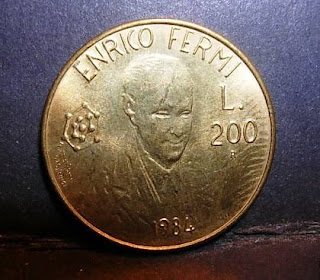 Today, we wish a Happy Birthday to Enrico Fermi. If he was still alive, Fermi would be 108 years old.
Today, we wish a Happy Birthday to Enrico Fermi. If he was still alive, Fermi would be 108 years old.
Fermi was a Nobel Laureate physicist who is commonly credited with harnessing the nuclear power. Fermi won the Nobel Prize in Physics in 1938 “for his demonstrations of the existence of new radioactive elements produced by neutron irradiation, and for his related discovery of nuclear reactions brought about by slow neutrons” This work made him an important contributor to the Manhattan Project.
Fermi, who is considered one of the premier scientists of the 20th century, was granted 14 patents and was instrumental in the development of nuclear energy. He is called the father of nuclear energy.
In 1984, the Republic of San Marino,the oldest sovereign state and constitutional republic in the world, issued a 200 Lire commemorative coin (KM# 166) honoring Fermi on the 30th anniversary of his death. The coin is made of copper-nickel and is worth about $2.50 as an uncirculated coin.
Happy Birthday, Enrico, and thank you for sharing your work with the world!
Sorry, I forgot where I found the picture to give that person credit.
Sep 23, 2009 | bullion, history, US Mint
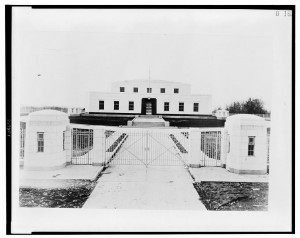
Treasury Department, Procurement Division, Public Buildings Branch, Fort Knox – United States Bullion Depository (1939)
Outside visitors are rare. Following President Franklin D. Roosevelt’s inspection trip in 1943, no outsiders have been allowed to visit the facility. Following an audit that was completed in 1953, the vaults were sealed and nobody was allowed to visit.
In 1974, noted conspiracy theorist Dr. Peter Beter wrote a book titled The Conspiracy Against the Dollar that alleged “powerful Americans have secretly permitted $20 billion worth of gold to be removed from Ft. Knox.” The claim caught on and the public clamored to prove that the nation’s gold was still in Fort Knox.
After clamoring from the public, congressed impressed on the Secretary of the Treasury William Simon and Director of the US Mint Mary Brooks to open the doors of the vault to public inspection. It was finally agreed that a select group of congress members and press would visit Fort Knox on September 23, 1974.
On September 20, 1974, the US Mint release the following press release:
FOR IMMEDIATE RELEASE
September 20, 1974
INSPECTION OF GOLD AT FORT KNOX
The inspection by Members of Congress on September 23, 1974, of U.S. gold stocks stored at the Fort Knox (Ky.) Bullion Depository marks a unique departure from the long standing and rigidly enforced policy of absolutely no visitors, Mrs. Mary Brooks, Director of the Mint, announced today.
“On April 28, 1943, President Franklin D. Roosevelt inspected the Bullion Depository,” Mrs. Brooks said. “His visit was the one and only time a gold vault was opened for inspection for anyone other than authorized personnel.
“The Congressional inspection adheres to the new open door policy of the government announced by President Ford. Treasury Secretary William E. Simon issued the invitation to Congressmen to inspect the gold at Fort Knox. By also inviting the press to witness the Congressional inspection, the Mint is clearing away cobwebs and re-assuring the public that their gold is intact and safe. For the first time photographing is being permitted inside the Depository.”
After the Congressional inspection, the Bullion Depository will once again be closed to visitors.
On September 24, 1974, a special settlement (audit) is scheduled to begin and at its conclusion a report on the audit will be issued.
The audit will be performed by a committee of auditors from the U.S. General Accounting Office (GAO) and the Department of the Treasury. The auditors from the Treasury will be drawn from the Office of the Secretary, the Bureau of Government Financial Operations, the U.S. Customs Service, and the Bureau of the Mint. In addition, the committee will include technicians from the Bureau of the Mint who are trained in assaying and weighing gold bullion.
The monetary gold stock of the United States totals 276.0 million fine troy ounces valued at $11.7 billion at the official rate of $42.2222 per fine troy ounce, and is stored in various federal depositories (table attached), the largest of which is at Fort Knox, Kentucky. 147.4 million fine troy ounces, valued at $6.2 billion, is stored in 13 vault compartments at Fort Knox Bullion Depository.
MONETARY GOLD STOCK OF THE UNITED STATES
(in millions of ounces)
| Account of the U.S. Treasury |
|
|
| Fort Knox |
147.4 |
|
| Denver Mint |
54.9 |
|
| New York Assay Office |
54.1 |
|
| San Francisco Assay Office |
10.6 |
|
| FRB New York – Special Custody Acct. |
4.2 |
|
| Bank of England |
1.3 |
|
| Bank of Canada |
1.4 |
|
| Other |
.1 |
|
| |
|
274.0 |
| Exchange Stabilization Fund |
|
2.0 |
| Total |
|
276.0 |
For more on the Fort Knox visit, you should read the article by David Ganz, who attended as a freelance writer after skipping a day at law school.
Recently, the History Channel aired a show, Fort Knox – Secrets Revealed that was produced in 2007. “Hidden deep inside the vault is an estimated $73 billion dollars in gold. Almost all information about it is classified. Through interviews with eyewitnesses, rare photos and rarely seen films, we will construct a picture of what the building might look like. Hear testimony of those journalists and congressmen who were among the select few invited inside in 1974.”
If you cannot wait for the History Channel to air the show, you can purchase a DVD copy for yourself from Amazon.com. The link to the right will bring you right to the page to purchase the DVD.
Aug 28, 2009 | history
My silence the last few weeks has been because of a family crisis. My mother was diagnosed with Lupus 15 years ago and has been trying to fight the attacks over the years. This week, the Lupus won and she died quietly with her husband (my father), sister, and a rabbi at her side. I will write more about her later. But I wanted to post something now.
The following was written by
WoodenJefferson on the
NGC Forums. I thought it was a good story and received his permission to share it with my readers.
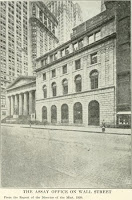 On September 16, 1920, the flood of Wall Street lunch goers did not even notice a nondescript man on a red horse-drawn cart outside the U.S. Assay Office. After the man quickly disappeared into the crowd, the cart suddenly exploded, killing more than 30 people and injuring nearly 400 as metal fragments rained from the sky. Both the horse and wagon were entirely destroyed in the noon time blast.
On September 16, 1920, the flood of Wall Street lunch goers did not even notice a nondescript man on a red horse-drawn cart outside the U.S. Assay Office. After the man quickly disappeared into the crowd, the cart suddenly exploded, killing more than 30 people and injuring nearly 400 as metal fragments rained from the sky. Both the horse and wagon were entirely destroyed in the noon time blast.
Speculations of conspiracy and terrorism abounded, but crews cleaned the damage overnight (not realizing they were destroying crucial evidence), leaving almost no clues behind.
The best tip came prior to the explosion. A letter carrier found four crudely spelled and printed flyers in the area from a group demanding the release of political prisoners. The group, called the “American Anarchist Fighters,” resembled the Italian Anarchists that used similar flyers in two prior bombing campaigns.
The FBI originally suspected followers of Italian Anarchist Luigi Galleani, but the case could not be proved and promising trails became dead ends.
The Wall Street Explosion occurred in New York City at one minute before noon on the day of the explosion, across from the headquarters of the J.P. Morgan Company on Wall Street near the corner of Broad Street. The junction was the financial epicenter of the United States—the J.P. Morgan Company, the N.Y. Stock Exchange, the U.S. Assay Office, the Sub-Treasury Building all surrounded the site. It was a system bitterly hated by the radicals and known anarchists.
Although persons were killed or injured in the street, no one inside the surrounding buildings were harmed. Ironically, the bomb that rocked the entire lower end of Manhattan claimed not the reviled financial giants but rather the “little people”: the clerk, the stenographer, delivery boys. Wall Street was in utter shambles. A huge crater was blown into the street.

Thousands of people lined up the streets to see the blood-soaked avenue. The New York Daily News photographer George Schmidt was among the first to arrive and photographed the scene.
The New York Assay Office was rebuilt and opened in April, 1921 with a vault capable of holding $5 billion in gold. Today, that vault area is used by the Federal Reserve Bank of New York.
The New York Assay Office was established by the Act of March 3, 1853. It opened in 1854. The Treasury closed this office on December 31, 1982.
Image of US Assay Office of New York was published in The Site of the Assay Office on Wall Street by William E. Verplank, 1921
Photo of the aftermath of the 1920 explosion is courtesy of Iconic Photos.
Click on the image to enlarge.
Jul 25, 2009 | coins, currency, history, video
Regular readers know I have an affection for television shows that are a cross between reality and history. This is why I like to watch The History Channel. On of my favorite shows on The History Channel is Modern Marvels, a show that shows the “secrets”s behind things we find in modern life. From ultimate gadgets to looking at the technology of our past, I find the show fascinating.
Thanks to a posting on the Collectors Society Forums, I found that Modern Marvels was doing a show about money. For fans of the show, The History Channel posted three of the segments on their website.
The first segment, titled “Centralization of Money” give a brief history of money in the United States from the chaos of every bank issuing currency through the basics of how the Federal Reserve interacts with the Bureau of Engraving and Printing and the US Mint.
In the second posted segment titled “Currency” traces its history from the Civil War to how the paper is made. Cameras follow the process through the creation of the cotton from blue jeans by Crane & Company. I like the animation as to how the intaglio printing works.
Finally, “Coin Production” also has a great animation that shows how master dies are used to make striking dies. Then the camera moves to the Mint’s production floor to show how the coins are made.
The History Channel does not allow us to embed their images on our websites. But if you go to the first segment, you can watch the three segments in sequence. I love this stuff!
Mar 16, 2009 | coins, history
A friend sent an email note reminding me that today (March 16) is the 258th anniversary of James Madison’s birth and the 207th Anniversary of the founding of the United States Military Academy at West Point.
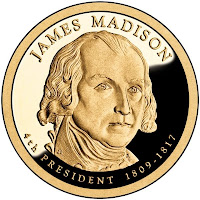 Madison, our 4th President, was the Commander-in-Chief during the War of 1812 and the victory over the British. He was a major contributor to the Federalist Papers and the framer of the Bill of Rights. Numismatically, the Madison Dollar was the last of the Presidential dollars issued in 2007.
Madison, our 4th President, was the Commander-in-Chief during the War of 1812 and the victory over the British. He was a major contributor to the Federalist Papers and the framer of the Bill of Rights. Numismatically, the Madison Dollar was the last of the Presidential dollars issued in 2007.
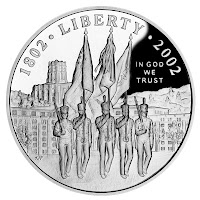 The United State Military Academy is the oldest of the service academies. West Point is considered the premier school of its type worldwide and its graduates includes war heroes, former presidents, and a famous college basketball coach. In 2002, the US Mint issued the West Point Bicentennial Dollar to commemorate 200 years of training our nation’s best.
The United State Military Academy is the oldest of the service academies. West Point is considered the premier school of its type worldwide and its graduates includes war heroes, former presidents, and a famous college basketball coach. In 2002, the US Mint issued the West Point Bicentennial Dollar to commemorate 200 years of training our nation’s best.
I mention this note because the friend who sent the note has a unique perspective on coin collection. He has taken the phrase “history in your hand” to heart and has built his collection around history represented by the coins. Rather than purchase albums to collect series of coins, he has three-ring binders with pages to present his collection in date order of significance.
Using 12 three-inch binders, date numbered tabs, and various mylar pages, he insert his collection into the area where there is the most significance. For example, he collected the 50 State Quarter coin covers and inserted them on the date corresponding to when the state was admitted into the union. His Presidential Dollar coin covers are stored based on the birth date of the president. In this system, March 16 has the James Madison dollar coin cover and the West Point Bicentennial commemorative.
It sounds unwieldy, but my friend has done a great job creating a collection that he uses to teach his children and their friends the significance of history and coinage. I will try to post pictures if he gives me permission.
The moral of this story is that there is no right way to collect coins. Collect what you like and how you like. If you slowed your collecting activities because of the economy, maybe you can come up with a new idea as to how to organize your collection.
Images courtesy of the US Mint.
Mar 4, 2009 | history, legislative
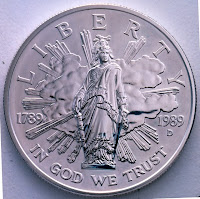 On March 4, 1789, the first congress convened under the new Constitution of the United States of America. Congress met at Federal Hall in New York City, the temporary capital until Washington, DC was built. Because March 4 was the first day of the constitutional government, it was the day that the president would be sworn in. This would last until the passage of the 20th Amendment of the Constitution in 1933.
On March 4, 1789, the first congress convened under the new Constitution of the United States of America. Congress met at Federal Hall in New York City, the temporary capital until Washington, DC was built. Because March 4 was the first day of the constitutional government, it was the day that the president would be sworn in. This would last until the passage of the 20th Amendment of the Constitution in 1933.
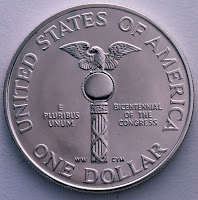 The formation and seating of congress predates the presidency. After meeting on March 4, committees were formed to create an infrastructure for the legislative branch, which was then debated on April 1, 1789, when congress had its first quorum. One of its first orders of business was to form the Electoral College that voted George Washington as the first President of the United States. Washington, who did not accept a salary, was the only president to be unanimously elected by the Electoral College for both of his terms.
The formation and seating of congress predates the presidency. After meeting on March 4, committees were formed to create an infrastructure for the legislative branch, which was then debated on April 1, 1789, when congress had its first quorum. One of its first orders of business was to form the Electoral College that voted George Washington as the first President of the United States. Washington, who did not accept a salary, was the only president to be unanimously elected by the Electoral College for both of his terms.
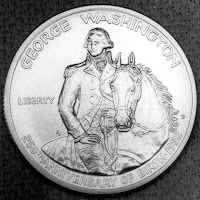 Washington appointed a cabinet and selected Alexander Hamilton as the first Secretary of the Treasury. In addition to setting up an economic system for the new country, Hamilton wrote a report to congress recommending a monetary system and a mint to strike coins in 1791. Congress did not pass the first Coinage Act until April 2, 1792.
Washington appointed a cabinet and selected Alexander Hamilton as the first Secretary of the Treasury. In addition to setting up an economic system for the new country, Hamilton wrote a report to congress recommending a monetary system and a mint to strike coins in 1791. Congress did not pass the first Coinage Act until April 2, 1792.
As collectors, we can thank and curse congress over the politics of coin making in the United Sates. But without them, we would have nothing to collect!
Coin images courtesy of the US Mint.












